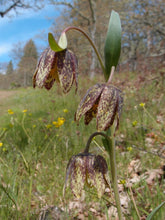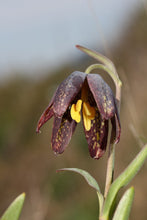
Fritillaria affinis
**PRODUCT NOTE - These bulbs will be available (in packs of 3) when you pick-up your plants in October. They cannot be pre-ordered since we will not know the total quantity available until the bulbs are dug in September. So, cross your fingers the voles lay off 'em and be sure to look for them at check out in October!
Checker lily, also known as chocolate lily, is a spring bulb named for its extraordinarily unique flower color and pattern. Unlike anything else in your northwest native garden, checker lily sports up to five nodding flowers with unmistakable brownish-purple pixelated mottling that are adored by gardeners and insect pollinators alike.
- Plant type/canopy layer: deciduous, perennial, herbaceous plant
- Size at maturity: up to 36" tall, 12" wide
- Light requirements: full sun, part sun/part shade
- Moisture requirements: moist soil
- Bloom time: March - June (April - June in the Portland Metro area)
- Growth rate/ease: medium growth rate, relatively easy to grow
- Wildlife support: flowers attract and provide nectar to adult butterflies, bees and other insect pollinators; overall plant attracts and supports beneficial and other pest-eating insects
- Native habitat/range: locally common in moist open meadows and woodlands, growing in the partial shade of taller foliage, from the coast to mid-elevations, in nearly every county west of the Cascades across the Pacific Northwest. Portland Plant List - yes.
- Special features & uses: meadowscapes, pollinator gardens, rock gardens or woodland gardens
Gardening with Checker Lily: Checker lilies will pop-up and thoroughly delight, before disappearing again until next year - so be sure to plant several and place them in areas where their exceptional blooms will be cherished. Select an area that is full sun, or dappled shade, with moist to dry soils that are well-drained and rich in organic matter. This relatively small plant works well as a perennial bulb border for meadowscapes, pollinator gardens, rock gardens and/or woodland gardens.
Planting Instructions:
- Fall Bulbs - Plant bulbs 4–6 inches deep and about 4–12 inches apart. Position the bulb on its side with the small nodules facing up. Cover with soil and water thoroughly.
- Spring Containers - Depending on the weather and the date of your order pick-up, bulbs may be just emerging or already dying back for the season. Bulbs can be fragile when they're actively growing in spring. So, either plant with care or keep it in its pot and wait until it dies back before planting. By early summer, the plant will die back completely and the bulb will be easy to transplant. If you go this route, leave the pot in a sheltered place and water sparingly, so that you don't rot the bulb. In the short term, consider placing a physical barrier (like a black plastic flat or the saucer for under a flowerpot) directly on top to deter small mammals from immediately digging it up.
Photo Credit 1: "Fritillaria affinis" by brewbooks is licensed under CC BY-SA 2.0.
Photo Credits 2, 3: Nikkie West, Sparrowhawk Native Plants
Photo Credit 4: "Fritillaria affinis 6603" by Walter Siegmund (talk) is licensed under CC BY-SA 3.0.







